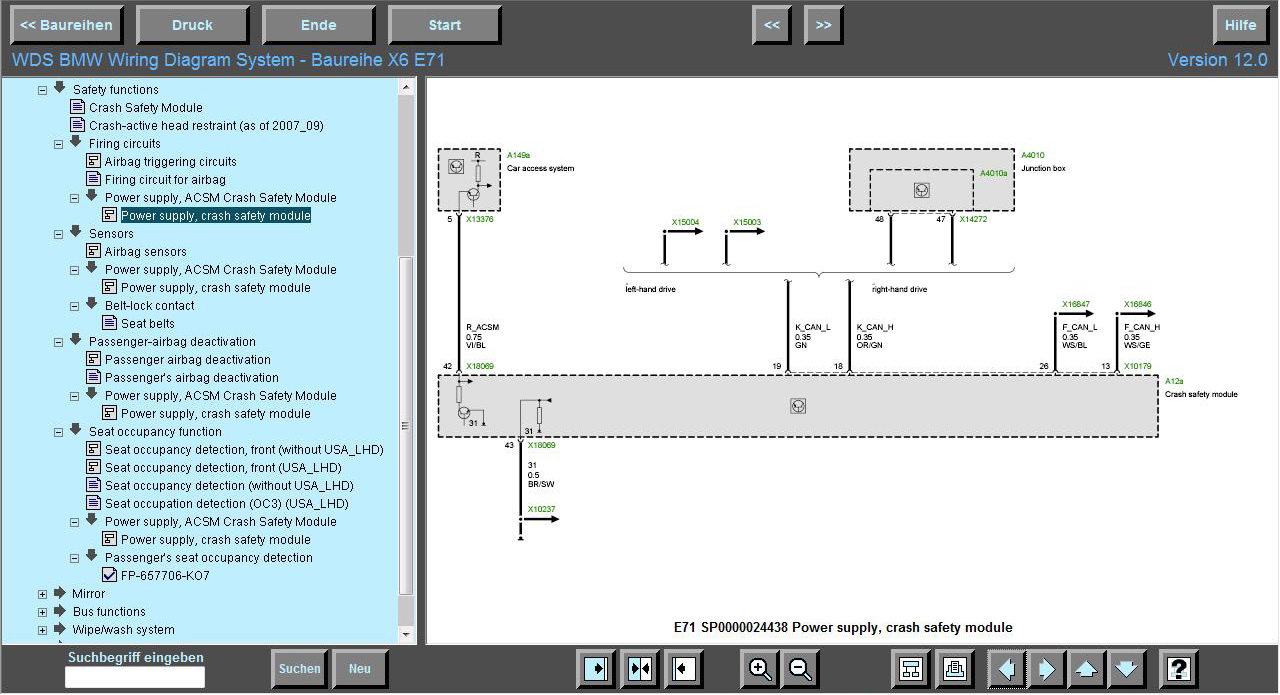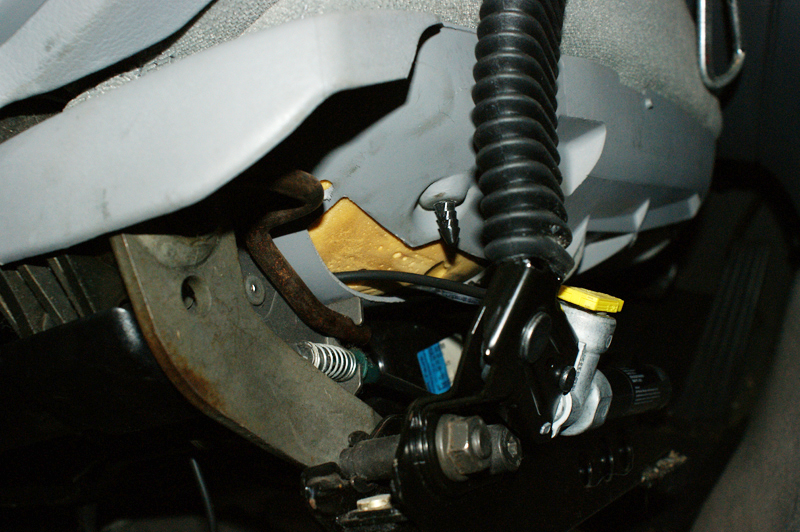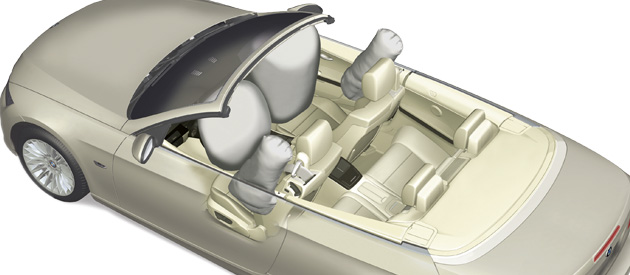
The purpose of an airbag is to gradually slow down the fragile human body after an impact. If an airbag were to deploy in front of you after your body had already moved forward, it would knock you backwards with significant force. It is supposed to fully deploy before your body has time to move forward, lessening the severity of the impact. Three-point seat and shoulder belts continue to be valuable safety devices. They keep you in the correct position to maximize the airbag’s effectiveness.
The complexities of the dynamics involved in a crash are incredible. BMW’s extensive research and development allow these restraint systems to minimize the occupants’ injuries with these carefully-designed safety systems. In addition, high strength steel helps maintain the cabin’s shape, crumple zones absorb much of the energy of an accident, and airbags mitigate the rate of deceleration of the body. This is why, after an accident, it is so critical to return the vehicle to its original pre-crash state. It is essential that the vehicle’s safety systems provide the same level of protection and after-collision performance as when it left the factory.
Evolution, Not Revolution
Combination seat belt/shoulder harness assemblies have been standard equipment on BMWs for decades. In 1990, BMW added seat belt pre-tensioners. In a collision, an explosive charge (a mechanical system on the 3 series) tightens the seat belts in use to further restrain the occupant’s movement inside the cabin.

Driver’s-side airbags have been around since the mid-eighties. Passenger’s side airbags have been used since the early nineties as well. In the mid-nineties, BMW started to implement seat-occupancy recognition systems, and the “intelligent†airbag system, also known as a dual-threshold deployment system. In less-severe collisions, or when a seat belt is not fastened, only one airbag will deploy. In a more severe crash both airbags are deployed simultaneously and offer better high impact protection.
In 1996, door-mounted side airbags were added. These protect the occupants’ bodies in the event of a side impact. BMW did not stop there. In 1997, BMW introduced HPS, the Head Protection System. Sometimes referred to as a curtain airbag, it protects an occupant’s head in the event of a collision. Rear side airbags were also offered as an option then.
In 1997, the innovative BST, Battery Safety Terminal, cable was also introduced. This positive battery terminal has an explosive charge in it that disconnects the battery from the rest of the vehicle during a collision. This helps reduce the possibility of an electrical spark igniting any flammable liquids or other materials that might be present during an accident.
Dual-stage airbags were introduced in 1999. Here, a sensing system evaluates the severity of an impact and determines what combination of airbags will be deployed. With these and other advancements, today BMW no longer refers to these safety systems as airbags, SRS or SIR. They are now simply called MRS for Multiple Restraint Systems.
Roll Call
With all of this safety technology in BMW vehicles, it is important to know the new terminology in order to understand how to repair these systems. Let us look at the latest X6 E71 chassis as an example. The main brain in charge of the multiple restraint system is the ACSM (Advanced Crash Safety Module), which receives its power from the CAS (Car Access System). This ACSM is in total control of every airbag in the system and receives sensor inputs from impact sensors placed throughout the vehicle. It processes these signals and determines which airbags should fire and in what combination.

Aside from receiving inputs from impact sensors the ACSM also has two acceleration sensors itself. One sensor is used to detect the severity of a forward or rearward collision. The other acceleration sensor detects side impacts. This is important. Since the control unit can determine what direction the impact comes from, it can manage the more advanced system features that have been added to promote occupant safety.
On this same E71 chassis, the ASCM has a total of eight impact sensors. The two front impact sensors are mounted just outboard of the radiator on both sides of the front side of the frame. There are two door impact sensors that mount in each door near the door handle. In addition, there are sensor assemblies mounted in the B pillar on each side of the vehicle. Each of these sensor assemblies has two sensors in it. The pillar-mounted impact sensor must be replaced as an assembly, so there are six serviceable impact sensors. This gives us a total of six external sensors and one ACSM that are serviceable components.

The E71 also has a total of eight airbags. The driver’s and passenger’s airbags are both dual-stage. They will need to be replaced as assemblies. There are two knee bolster-mounted airbags to protect the driver’s and passenger’s knees. The two side airbags are mounted in their respective seats. Two curtain airbags for the Head Protection System (HPS) are mounted on each side of the roof just above the doors.
Airbags are not the only components activated in an accident on the new X6. There are also four front seat belt pre-tensioners. Two are mounted on each front seat belt. One is on the buckle side and the other is on the belt side mounted in the B pillar. There are also two seat belt pre-tensioners mounted on each side of the rear seat belt buckles. What is relatively new here is the Active Head Restraint system. This deploys the headrest forward to reduce the distance between an occupant’s head and the headrest in rear-end collisions. Finally, we have the BST cable mounted on the positive terminal of the battery. This gives us a total of 17 serviceable igniting components in the MRS.
The ACSM has some additional inputs other than those from the crash sensors. The seat belt buckles have switches to indicate if they are latched. There is a switch that is discretely wired to the ACSM to turn on and off the passenger side airbags. There are also both driver’s and passenger’s side seat occupancy sensors mounted in the seat cushions. These sensors detect the approximate size of the occupants and their signals are used to calculate airbag deployment rates.
Modern BMW computer controls incorporate self-diagnostics to assist in troubleshooting, especially when dealing with airbag systems. BMW does not recommend using any electrical test equipment to test wiring or components, and strongly recommends that you use the self-diagnostic features of the BMW factory scan tool. You can use the ISTA feature on the BMW technical information website with an appropriate BMW ICOM interface, or approved passthrough device as your diagnostic tool. For more information on these procedures, take a look at www.bmwtechinfo.com “Online Service System.â€
Repair Procedures
Of course, when dealing with any airbag system you should take all necessary precautions in order to prevent injury. The system should only be serviced with the key in the “0†position. The battery must be disconnected and you should wait at least a full minute before disconnecting any impact sensors or airbags from the vehicle. The BST cable kills power to the vehicle during an accident, but the ACSM has capacitors that continue to supply power to the control unit even after the battery is disconnected. This is why you must wait one minute before you start any service work on the vehicle.

Obviously, you will need to replace any deployed airbags. That is clear. What may not be clear is if the Active Head Restraint system has been deployed. Also, the seat belt pre-tensioners may need to be replaced even if the accident was not severe enough to deploy the airbags. For particular models, the means of finding out if these units must be replaced can be found at www.bmwtechinfo.com.
The ACSM is capable of recording vehicle information during a crash, similar to a “black box” in an airliner. This information can be retrieved for the purposes of an investigation or insurance claim. The unit can record and retain information for up to three accidents. After that, the memory is full and cannot be cleared so the ACSM must be replaced. The ACSM is coded specifically to each individual vehicle, so the replacement will also need to be coded.
When you are performing repair work on the vehicle, you are expected to unplug the ACSM before unplugging any additional components. Within the ACSM connector are shorting bars that bridge all of the wiring together to prevent any accidental firings. If welding is involved, you should also remove all possible ignition devices in order to prevent any accidental deployment during the repair.
Winding Up
BMW’s reputation for safety is impressive. After a collision, the BMW owner expects the vehicle to be returned to its pre-crash performance capabilities. Not just cosmetically, but also in terms of crash worthiness. It is essential that you use the proper tools, parts, and procedures to assure that all safety systems will perform as designed. These same procedures will also help prevent injury during repair. â—





0 Comments